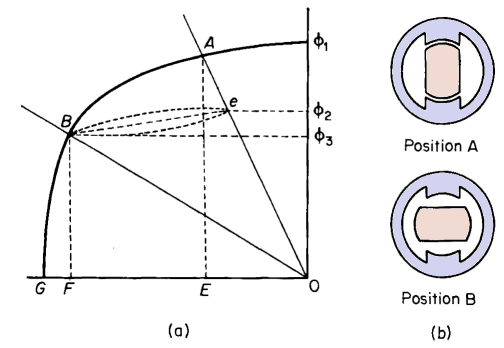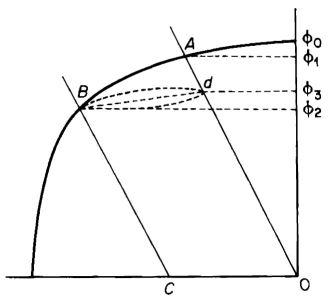| Capacitors, Magnetic Circuits, and Transformers is a free introductory textbook on the physics of capacitors, coils, and transformers. See the editorial for more information.... |

|

Home  Magnetic Circuits Magnetic Circuits  Operating Characteristics of Permanent Magnets Operating Characteristics of Permanent Magnets |
|||||||






|
|||||||
Operating Characteristics of Permanent Magnets
Variations in the flux of permanent magnets are caused by certain operating conditions. Many devices using permanent magnets have fixed air gaps, but there are others, such as magnetos and permanent-magnet generators and motors, in which flux variation may be produced by external demagnetizing forces resulting from the generator or motor current or external magnetic fields. Variations in the length of air gap for various positions of the rotor produce variations in the flux of permanent magnets.
Figure 3-34 shows an arrangement consisting of a permanent magnet, usually alnico, with suitable pole pieces of iron and an iron armature pivoted at its center so that it is free to oscillate in the plane of the pole pieces. The iron armature carries a winding in which a current produces opposite poles at the ends of the armature. If this current is alternating, the armature oscillates atthe frequency of the current. As a result there are variations in the reluctance of the air gap. The magnetic circuit of a permanent-magnet generator is shown in Fig. 3-35. The length of the air gap undergoes variations as the rotor occupies different angular positions.
The effect of a demagnetizing force on the flux of a permanent magnet is demonstrated by means of the demagnetization curve for a permanent magnet in Fig. 3-36. Suppose that the air gap of this permanent magnet is short-circuited by means of soft iron and a very high magnetizing force is applied. This is accomplished by passing a very heavy current, for a relatively short time period, through one or more turns of winding, linking the magnetic circuit. After the current has fallen to zero, the flux has dropped to the value Φ0 as shown in Fig. 3-36. If the soft iron short circuit is removed from the air gap, the flux drops from Φ0 to Φ1 as determined by the point A on the intersection of the demagnetization curve with the air-gap line. If a demagnetization force of OC amp turns is now applied to the magnetic circuit, the flux falls from Φ1 to Φ2 as determined by the point on the intersection of the
demagnetization curve when the air-gap line is shifted to the left by an amount equal to OC. If the demagnetization force OC is now removed, the flux will not rise from Φ2 back to Φ1 but to some lower value Φ3. The point B will not follow the original characteristic back to point A, but will follow along the lower portion of the minor hysteresis loop to point d. Use is made of this effect to stabilize permanent magnets by applying an opposing mmf OC to the magnet. In the original application of the mmf OC, the flux dropped from a value of Φ1 to Φ2, whereas successive applications of the same value of mmf will produce a change in the flux only from Φ3 to Φ2 In dealing with a permanent magnet that has been stabilized, it may be assumed with reasonable accuracy that the locus of the flux is along a straight line Bd, which has the same slope as the demagnetization curve at Φ0 Consider now the effect of the variation of air-gap length. Figure 3-35(a) shows the demagnetization curve of a permanent-magnet generator, the magnetic circuit that is shown in Fig. 3-35(b). When the rotor of the generator is in position A the effective length of the air gap is a minimum. With the rotor in position B the effective length of the air gap is a maximum. The rotor in this generator would preferably be the permanent magnet and the armature winding would be placed on the stator. Such an arrangement would obviate the use of slip rings. The locus of operation on the demagnetization curve of Fig. 3-35(a) is the minor hysteresis loop between points B and e, and the flux oscillates between the values Φ2 to Φ3 twice for each revolution of the rotor.
|
|||||||
Home  Magnetic Circuits Magnetic Circuits  Operating Characteristics of Permanent Magnets Operating Characteristics of Permanent Magnets |
|||||||
Last Update: 2011-02-16




